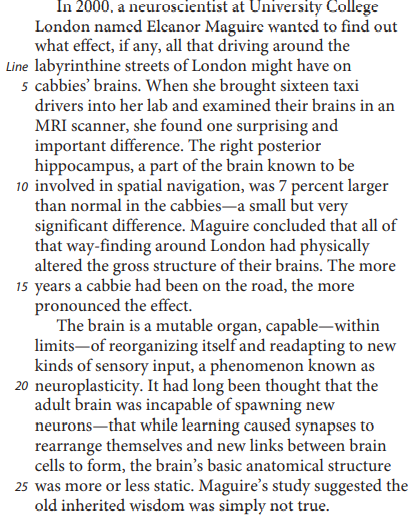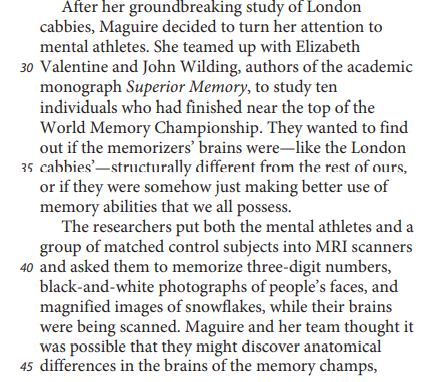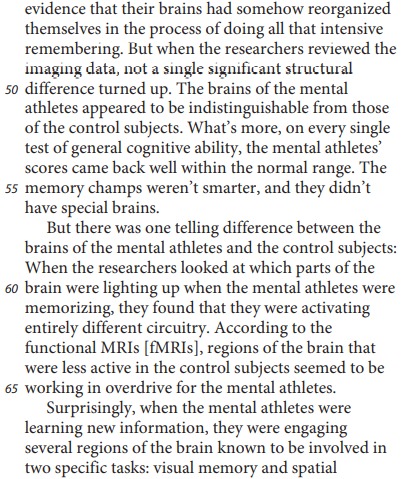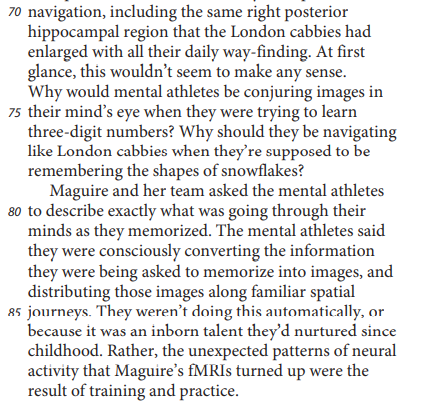SAT (Scholastic Assessment Test) is a standard test, used for taking admission to undergraduate programs of universities or colleges of the United States. SAT is developed and published by the College Board, an organization in the United States, administered by the Educational Testing Service. In this article of AKVTutorials, you will get Princeton Online SAT Prep Course Book Review | Practice Test 25 AMBiPi.
Princeton Online SAT Prep Course Book
The Princeton Review for SAT Premium Book review is given in the article Click Here.
SAT Reading Practice Passage
This passage is adapted from Joshua Foer, Moonwalking with Einstein: The Art and Science of Remembering Everything. ©2011 by Joshua Foer.




SAT Reading Comprehension Practice Test Questions
SAT Practice Test 25 Question No 1
According to the passage, Maguire’s findings regarding taxi drivers are significant because they
Option A: demonstrate the validity of a new method.
Option B: provide evidence for a popular viewpoint.
Option C: call into question an earlier consensus.
Option D: challenge the authenticity of previous data.
SAT Practice Test 25 Answer No 1
Show/Hide Answer
Option C :
According to the passage, Maguire found that taxi drivers’ hippocampi are “7 percent larger than normal,” which is evidence that “way-finding around London had physically altered the gross structure of their brains” (lines 10-14). In lines 20-26, the passage indicates that this finding challenges an earlier consensus: “It had long been thought that the adult brain was incapable of spawning new neurons—that . . . the brain’s basic anatomical structure was more or less static. Maguire’s study suggested the old inherited wisdom was simply not true.”
Choice A is incorrect because the passage does not indicate that Maguire used a new method in her study or that her findings demonstrate the validity of a method. Choice B is incorrect because lines 20- 26 show that Maguire’s findings disprove a popular viewpoint, not that they support one. Choice D is incorrect because although Maguire’s findings call into question a previous idea, there is no indication that they challenge the authenticity of any previous data.
SAT Practice Test 25 Question No 2
Which choice provides the best evidence for the answer to the previous question?
Option A: Lines 8-12 (“The right… difference”)
Option B: Lines 12-16 (“Maguire… effect”)
Option C: Lines 17-20 (“The brain… neuroplasticity”)
Option D: Lines 20-26 (“It had… true”)
SAT Practice Test 25 Answer No 2
Show/Hide Answer
Option D :
The previous question asks about the significance of Maguire’s findings, with the answer being that her findings call into question a previous belief. This is supported in lines 20- 26: “It had long been thought that the adult brain was incapable of spawning new neurons—that . . . the brain’s basic anatomical structure was more or less static. Maguire’s study suggested the old inherited wisdom was simply not true.”
Choices A, B, and C are incorrect because the lines cited do not support the answer to the previous question about the significance of Maguire’s findings. Choices A and B are incorrect because these lines present Maguire’s observation and her conclusion but do not indicate that her findings call into question a previous belief. Choice C is incorrect because these lines simply explain one capability of the human brain.
SAT Practice Test 25 Question No 3
As used in line 24, “basic” most nearly mean
Option A: initial.
Option B: simple.
Option C: necessary.
Option D: fundamental.
SAT Practice Test 25 Answer No 3
Show/Hide Answer
Option D :
In line 24, the passage discusses the “brain’s basic anatomical structure.” In this context, the word “basic” most nearly means fundamental.
Choices A, B, and C are incorrect because in the context of discussing the brain’s structure, the word “basic” most nearly means fundamental, not first (choice A), uncomplicated (choice B), or required (choice C).
SAT Practice Test 25 Question No 4
Which question was Maguire’s study of mental athletes primarily intended to answer?
Option A: Does the act of memorization make use of different brain structures than does the act of navigation?
Option B: Do mental athletes inherit their unusual brain structures, or do the structures develop as a result of specific activities?
Option C: Does heightened memorization ability reflect abnormal brain structure or an unusual use of normal brain structure?
Option D: What is the relationship between general cognitive ability and the unusual brain structures of mental athletes?
SAT Practice Test 25 Answer No 4
Show/Hide Answer
Option C :
The purpose of Maguire’s study of the mental athletes was to try to determine what it is that makes them so good at memorization, and in particular if they have structurally different brains than people without such extraordinary memorization skills or if they have normal brain structures but use them in unusual ways. This is supported in lines 33-37, which state that Maguire and her team “wanted to find out if the memorizers’ brains were—like the London cabbies’— structurally different from the rest of ours, or if they were somehow just making better use of memory abilities that we all possess.”
Choice A is incorrect because the study was an attempt to compare the brains of mental athletes to the brains of the general population, not to compare the use of different brain structures in memorization and navigation. Choices B and D are incorrect because the passage makes it clear that it was not known if mental athletes have unusual brain structures; finding out if they do was actually one of the goals of the study.
SAT Practice Test 25 Question No 5
Which choice provides the best evidence for the answer to the previous question?
Option A: Lines 27-29 (“After… athletes”)
Option B: Lines 33-37 (“They… possess”)
Option C: Lines 38-43 (“The researchers… scanned”)
Option D: Lines 52-54 (“What’s… range”)
SAT Practice Test 25 Answer No 5
Show/Hide Answer
Option B :
The previous question asks what Maguire’s study of mental athletes attempted to answer, with the answer being the question of whether it is brain structure or an unusual use of the brain that gives certain people extraordinary memorization skills. This is supported in lines 33-37: “They wanted to find out if the memorizers’ brains were—like the London cabbies’—structurally different from the rest of ours, or if they were somehow just making better use of memory abilities that we all possess.”
Choices A, C, and D are incorrect because the lines cited do not support the answer to the previous question about what Maguire’s study of mental athletes was investigating. Instead they simply identify the subject of the study (choice A), explain what the study involved (choice C), and state a finding concerning the cognitive ability of the mental athletes (choice D).
SAT Practice Test 25 Question No 6
As used in line 39, “matched” most nearly means
Option A: comparable.
Option B: identical.
Option C: distinguishable.
Option D: competing.
SAT Practice Test 25 Answer No 6
Show/Hide Answer
Option A :
In lines 38-39, the passage describes part of Maguire’s study by stating that “the researchers put both the mental athletes and a group of matched control subjects into MRI scanners.” In the context of a study that has two groups of subjects, the word “matched” suggests subjects that are similar or comparable.
Choices B, C, and D are incorrect because in the context of a study with two groups of subjects, the word “matched” suggests subjects that are similar or comparable, not ones that are exactly the same (choice B), ones that are recognizably different (choice C), or ones that are rivals (choice D).
SAT Practice Test 25 Question No 7
The main purpose of the fifth paragraph (lines 57-65) is to
Option A: relate Maguire’s study ofmental athletes to her study of taxi drivers.
Option B: speculate on the reason for Maguire’s unexpected results.
Option C: identify an important finding of Maguire’s study of mental athletes.
Option D: transition from a summary of Maguire’s findings to a description of her methods.
SAT Practice Test 25 Answer No 7
Show/Hide Answer
Option C :
The main purpose of the fifth paragraph (lines 57-65) is to relate what Maguire discovered about the mental athletes, namely that their brain structures are not different from those of the control group but that the mental athletes use their brains differently: “there was one telling difference . . . regions of the brain that were less active in the control subjects seemed to be working in overdrive for the mental athletes.”
Choice A is incorrect because the fifth paragraph does not mention the taxi drivers or the study involving them. Choice B is incorrect because the fifth paragraph describes some of the unexpected results of Maguire’s study but does not address the possible reasons for those results. Choice D is incorrect because the fifth paragraph describes only Maguire’s findings, not her methods.
SAT Practice Test 25 Question No 8
According to the passage, when compared to mental athletes, the individuals in the control group in Maguire’s second study
Option A: showed less brain activity overall.
Option B: demonstrated a wider range of cognitive ability.
Option C: exhibited different patterns of brain activity.
Option D: displayed noticeably smaller hippocampal regions.
SAT Practice Test 25 Answer No 8
Show/Hide Answer
Option C :
The passage indicates that Maguire’s second study revealed that people in the control group don’t have different brain structures than the mental athletes but that they use their brains differently. In particular, the two groups use different pathways in the brain: “regions of the brain that were less active in the control subjects seemed to be working in overdrive for the mental athletes” (lines 63-65).
Choices A and D are incorrect because the passage states that there was only “one telling difference between the brains of the mental athletes and the control subjects” (lines 57-58); there is no indication that the control group showed less total brain activity or had smaller hippocampal regions. Choice B is incorrect because the passage mentions only the general cognitive ability of the mental athletes, noting that their scores were “within the normal range” (line 54).
SAT Practice Test 25 Question No 9
The passage most strongly suggests that mental athletes are successful at memorization because they
Option A: exploit parts of the brain not normally used in routine memorization.
Option B: convert information they are trying to memorize into abstract symbols..
Option C: organize information into numerical lists prior to memorization.
Option D: exercise their brains regularly through puzzles and other mental challenges.
SAT Practice Test 25 Answer No 9
Show/Hide Answer
Option A :
After establishing in lines 50-51 that the brains of the control group and the mental athletes seemed to be “indistinguishable,” the passage suggests that the reason mental athletes are so good at memorization is that they use parts of their brains that most other people don’t use when memorizing: “Surprisingly, when the mental athletes were learning new information, they were engaging several regions of the brain known to be involved in two specific tasks: visual memory and spatial navigation, including the same right posterior hippocampal region that the London cabbies had enlarged with all their daily way-finding” (lines 66-72).
Choices B and C are incorrect because the passage explains that the mental athletes were converting information into images, not abstract symbols or numerical lists. Choice D is incorrect because it is not supported by the passage, as the author discusses the mental athletes’ actions while memorizing but not any brain exercises the mental athletes regularly do.
SAT Practice Test 25 Question No 10
Which choice provides the best evidence for the answer to the previous question?
Option A: Lines 66-72 (“Surprisingly… way-finding”)
Option B: Lines 72-73 (“At first… sense”)
Option C: Lines 79-81 (“Maguire… memorized”)
Option D: Lines 85-87 (“They… childhood”)
SAT Practice Test 25 Answer No 10
Show/Hide Answer
Option A :
The previous question asks what the passage suggests about the mental athletes’ success with memorization, with the answer being that they use parts of the brain that most other people don’t use when memorizing. This is supported in lines 66-72: “Surprisingly, when the mental athletes were learning new information, they were engaging several regions of the brain known be involved in two specific tasks: visual memory and spatial navigation, including the same right posterior hippocampal region that the London cabbies had enlarged with all their daily way-finding.”
Choices B, C, and D are incorrect because the lines cited do not support the answer to the previous question about what the passage suggests about the mental athletes’ success with memorization. Instead, they acknowledge that Maguire’s findings seem odd (choice B), describe how Maguire first responded to the results (choice C), and explain things that don’t account for the mental athletes’ ability (choice D).




